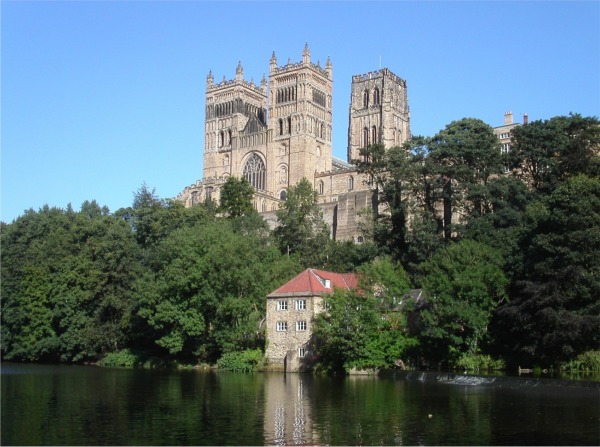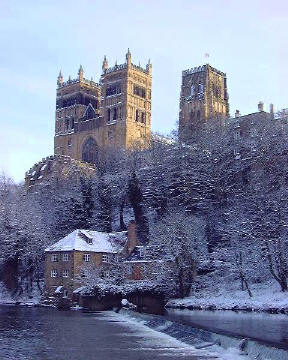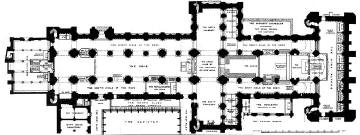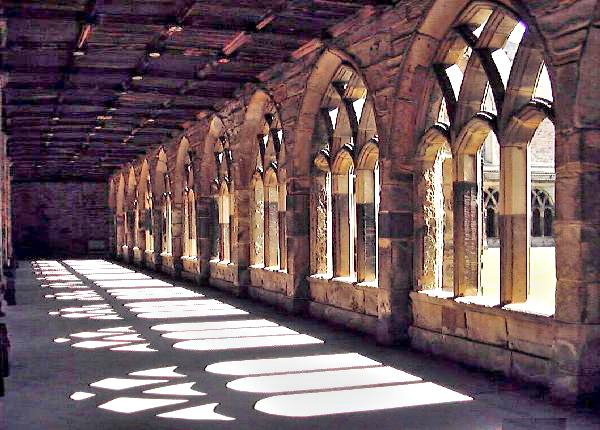Durham Cathedral
Durham, Durham
|

Location Guide |
"A part of the World
Heritage Site - Durham Castle and Cathedral"

Durham cathedral, picture by
Tom Pennington


If this looks familiar it may be that you have
seen pictures of it before or that you have seen it in other representations.
Durham Cathedral has been featured in the Harry Potter films as Hogwarts School
of Witchcraft and Wizardry, where it had a spire digitally added onto the top of
the famous towers.
Durham Cathedral or by its formal name The
Cathedral Church of Christ, Blessed Mary the Virgin and St Cuthbert of Durham, is one of the finest examples of a Norman cathedral in Europe and has been
designated a UNESCO World Heritage Site along with nearby Durham Castle, which
faces it across Palace Green, high above the River Wear. It is perhaps not as
old as some cathedrals but has an interesting history.
The Bishops of Durham were also territorial
Prince Bishops, with the extraordinary secular rank of Earl palatine, for it was
their duty not only to be head of the large diocese, but also to help protect
the Kingdom against the Scottish threat from the north. The title survived the
union of England and Scotland into the Kingdom of Great Britain in 1707 until
1836.
The bishops of Durham were very powerful
prince-bishops up to the mid-nineteenth century. The seat of Bishop of Durham is
still the fourth most significant in the Church of England hierarchy, and he
stands at the right hand of the monarch at coronations. Signposts for the modern
day County Durham are nowadays subtitled "Land of the Prince Bishops."
You can find out more about prince bishops and
princes of the church, from the other website links below. In Britain a number
of Bishops have similar rank and sit as members of the House of Lords.
The Cathedral houses the shrine and related
treasures of Cuthbert of Lindisfarne, a seventh century saint, and these are on
public view. It is also home to the head of St Oswald of Northumbria and the
remains of the Venerable Bede. One can also climb the 325 steps to the top of
the 217 feet (66 m) tall tower to enjoy an outstanding view of Durham and the
surrounding area.
Getting to Durham
The see of Durham takes its origins from the Diocese of Lindisfarne, set
up by Saint Aidan at the behest of Oswald of Northumbria around AD 635.
The see lasted until AD 664, at which point it was translated to York.
The see was then reinstated in AD 678 by the Archbishop of Canterbury.
The community at Lindisfarne Priory produced many saints, of which Saint
Cuthbert is central to the development of Durham Cathedral.After repeated Viking raids the monks fled Lindisfarne in AD 875,
carrying St Cuthbert's relics with them. The diocese of Lindisfarne
remained itinerant until 882, when a community was re-established in
Chester-le-Street. The see had its seat here until 995, when further
incursions once again caused the monks to move with the relics.
According to local legend, the monks followed two milk maids who were
searching for a dun (i.e. brown) cow and were led into a peninsula
formed by a loop in the River Wear. At this point Cuthbert's coffin
became immovable and this was taken as a sign that the new shrine should
be built here. A more prosaic set of reasons for the selection of the
peninsula is its highly defensible position, and that a community
established here would enjoy the protection of the Earl of
Northumberland, as the bishop at this time, Aldhun, had strong family
links with the earls. Nevertheless, the street leading from The Bailey
past the Cathedral's eastern towers up to Palace Green is named Dun Cow
Lane. |

Picture by
Robin Widdison

 |
Initially, a very simple temporary structure
was built from nearby timber to house the relics of Cuthbert. The shrine was
then transferred to a sturdier, probably wooden, building known as the White
Church. This church was itself replaced three years later in 998 by a stone
building also known as the White Church, by 1018 only the west tower was
unfinished. Durham soon became a site of pilgrimage, encouraged by the growing
cult of Saint Cuthbert. King Canute was one early pilgrim, granting many
privileges and much land to the Durham community. The defendable position, flow
of money from pilgrims and power embodied in the church at Durham ensured that a
town formed around the cathedral, establishing the early core of the modern
city.
Click on
smaller images too see a larger version
The Cathedrals Development
| The present cathedral was initially
designed and built under the first prince-bishop, William of St. Carilef.
Construction began in 1093, although William died before completion of
this phase in 1135, passing responsibility to his successor Ranulf
Flambard. The building is notable for the ribbed vault of the nave
roof, with pointed transverse arches supported on relatively slender
composite piers alternated with massive drum columns, and flying
buttresses or lateral abutments concealed within the triforium over the
aisles. These features appear to be precursors of the Gothic
architecture of Northern France a few decades later, doubtless due to
the Norman stonemasons responsible, although the building is considered
Romanesque overall. It was the skilled use of the pointed arch and
ribbed vault which made it possible to cover far more elaborate and
complicated ground plans than hitherto. The buttressing made it possible
both to build taller buildings and to open up the intervening wall
spaces to create larger windows. |

Picture of main naive by Trevor
Rickard, digitally edited to show more detail,
click here
 to see original to see original |
 |
|
Saint Cuthbert's tomb lies at the East and was
once an elaborate monument of cream marble and gold.
In the twelfth century, Bishop Hugh de Puiset added the Galilee Chapel at the
west end of the cathedral. Also known as The Lady Chapel, the Galilee Chapel
holds the remains of the Venerable Bede and of Bishop Langley, whose tomb
blocked the Great West Door of the cathedral.
William of St. Carilef, Ranulf Flambard, and Hugh de Puiset are all buried in
the cathedral's Chapter House, which lies opposite the cloisters and dates from
1140.
The thirteenth century saw the construction of the Chapel of the Nine Altars, at
the eastern end of the cathedral, beginning under Richard le Poore (1228-1237).
The central tower of this time was destroyed by lightning, so the current tower
dates from the fifteenth century.
|
Dissolution
Cuthbert's tomb was destroyed on the orders of Henry VIII in 1538, but
survives as a modest stone affair. Two years later, in 1540, the
Benedictine monastery at Durham was dissolved, although the cloisters
are well preserved architecturally, and its last prior - Hugh Whitehead
- became the cathedral's first dean. |

Plan of Durham cathedral,
click on image to see a larger version |
The Seventeenth Century
In 1650, Durham Cathedral was used by Cromwell as a makeshift prison to hold
Scottish prisoners-of-war after the Battle of Dunbar of September 3, 1650. It is
estimated that as many as 3,000 prisoners died in the cathedral itself, where
they were kept in inhumane conditions, largely without food, water or heat. The
prisoners destroyed much of the cathedral woodwork for firewood but Prior
Castell's clock, featuring the Scottish thistle, was spared. Their bodies were
buried in unmarked graves. The survivors were shipped as slave labour to North
America. In 1946 during work to install a new central heating system at the
Cathedral, a mass grave of the Scottish soldiers was uncovered. In 1993 the
Scottish Covenanter's Memorials Association discussed with the Cathedral the
construction of a memorial to the soldiers, however, this appears to have been
inconclusive, since no memorial has yet been created. A campaign properly to
respect and remember the "Dunbar Martyrs" was launched at the end of 2007,
aiming as a minimum to gain a Christian blessing for the dead and a memorial at
the Cathedral burial site or even possible exhumation of the remains and
reburial in Scotland.
1700 - 1900
The Chapel of the Nine Altars features a large seventeenth-century rose window,
rebuilt in the eighteenth century, and a statue of William Van Mildert, the last
prince-bishop (1826-1836) and driving force behind the foundation of Durham
University.

Cloisters, edited to show more
detail,
click here
 to see original Photo by Robin Widdison. to see original Photo by Robin Widdison.

|
Location: Durham Cathedral, Durham |
|
Grid Reference:
NZ273421 |
Ceremonial County:
Durham |
|
Map Link:
Multimap
|
Aerial photo:
Multimap (very clear) |
|
Getting there: Follow signs from city of
Durham or refer to map above. |
|
Access: |
Website:
Own |
|
Other Useful Websites:
wiki

Prince-Bishop see
http://en.wikipedia.org/wiki/Prince-bishop

Prince of the Church see
http://en.wikipedia.org/wiki/Prince_of_the_Church
 |
|
Email:
enquiries@durhamcathedral.co.uk |
|
Address: The Chapter Office, The College,
Durham |
|
Postcode: DH1 3EH |
Telephone: 0191 386 4266 |
|
Opening Times: Opening times of the cathedral are not shown on
their website, but services are, and from this you can deduce when the
building is open and also when services and other events are being held.
Other tourist attractions within the cathedral do have their opening times
shown, see below. |
|
Charges: No entry fee to cathedral, but there
are entry fees to specific items, i.e. tower, treasury, monks dormitory,
building and church exhibition, all of which have their own opening hours so
see
their website page
 for details.
for details. |
Nearby Locations:
Durham
Castle
 very near. very near. |
|
Other Location Pages:
List of all Anglican
cathedrals and other major Anglican churches in the UK

Abbey
section,
 including all major Christian buildings, regions orders, normal layouts and
history.
including all major Christian buildings, regions orders, normal layouts and
history.
World
Heritage Sites
 World Heritage Sites in the UK
World Heritage Sites in the UK

World
Heritage Sites - Further Information

|
|
Notes:
There is nothing on their website that
suggests any restriction on photography for your own use, but it may be wise
to email them before making a visit.
They hold an event once a year to allow people
to experience the way Benedictines lived, this is run in combination with a
nearby college who provide the accommodation etc. |
|

|
Please let us know any other information that we
can add to the Further information and Planning Grids or page and any errors that you discover. Before making a long trip to any location it is always
wise to double check the current information, websites like magazines may be
correct at the time the information is written, but things change and it is of
course impossible to double check all entries on a regular basis. If you have
any good photographs that you feel would improve the illustration of this page
then please let us have copies. In referring to this page it is helpful if you
quote the Page Ref and classification at the bottom of the Planning Grid above. To print the
planning grid select it then right click and print the selected area.
Please submit information on locations you discover so
that this system continues to grow.
|